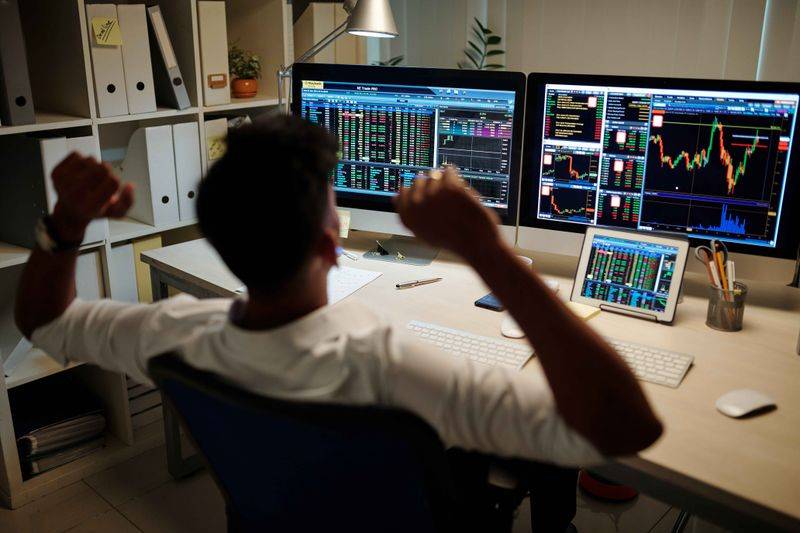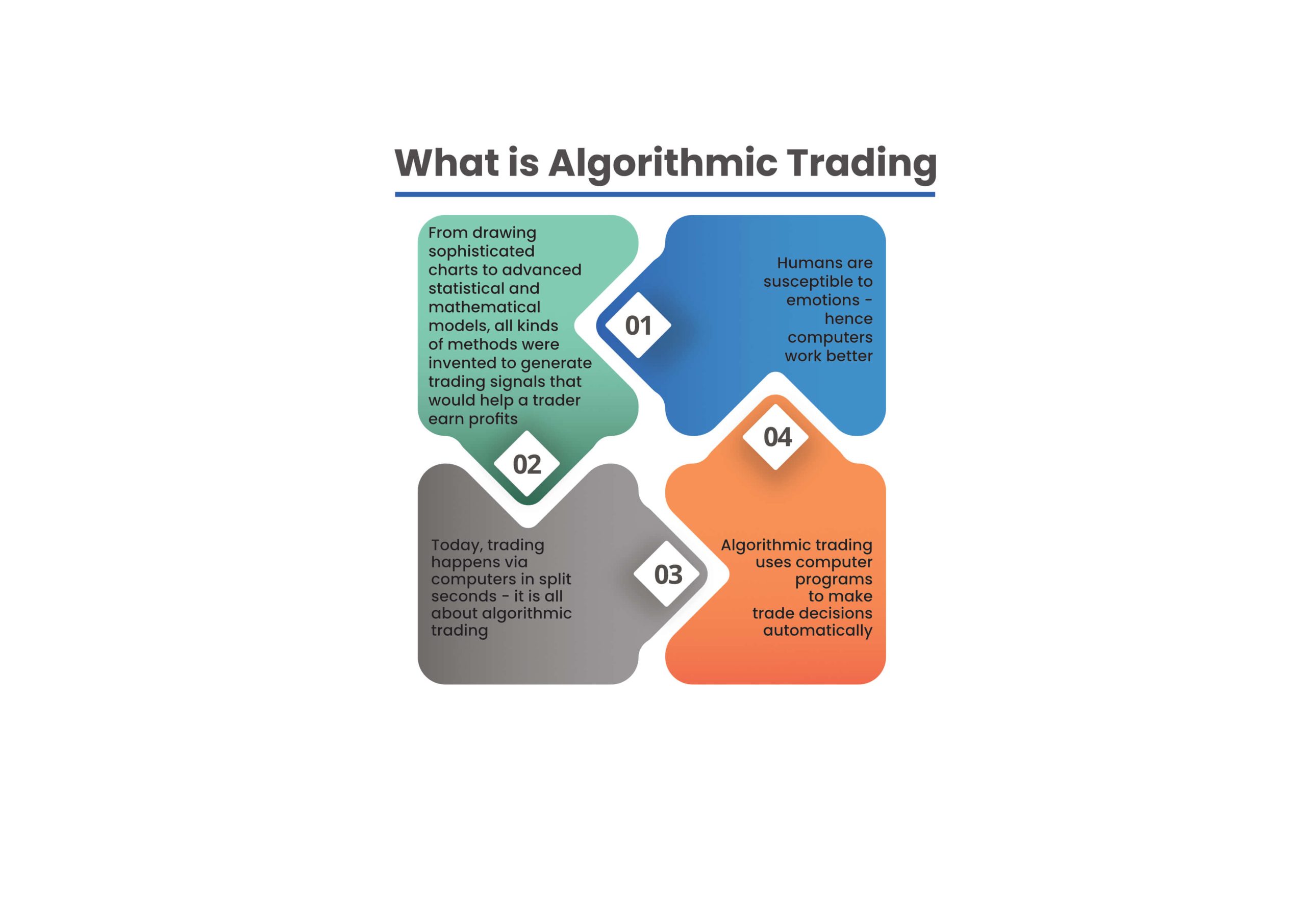
Algorithmic Trading is the use of computer programs to make trade decisions automatically. It follows specific rules using mathematical models and market conditions, providing efficient and precise execution while minimizing human error and emotional biases.
High-speed information flow. Decisions in the blink of an eye. A rush of adrenaline. In the good old days, the frenzy of a stock trading floor was pulsating, with hand signals moving millions of dollars and brokers shouting orders across each other. Today, trillions have replaced millions and are moved silently across accounts by computers in split seconds, the only noise being the soft hum of computer fans trying to cool the frenzy now locked inside their machines. All is calm outside. Welcome to the world of Algorithmic Trading, where men no longer solely lord the floors.
What is Algorithmic Trading

Trading can be impulsive, or it can be rule-based. Academia and your average Joe have cherished beliefs that stock market prices follow patterns or can be statistically predicted. But, of course, to counter them, there have always been those who believe that stock prices are random walks. So the former has always tried hard to arrive at sets of rules by which a trader can predict prices. From drawing sophisticated charts to advanced statistical and mathematical models, all kinds of methods were invented to generate trading signals that would help a trader gain an edge over her rival. Moreover, having computers led to the belief that crunching large enough data sets would coax such patterns out.
But having patterns, charts and signals was not good enough—there was the problem of good order execution. As was to be expected, trading humans were susceptible to emotion, looking over their shoulders, getting swayed by the crowd and prone to making mistakes. So it was inevitable that the same computers used to crunch data and generate signals would take over the last-mile execution, and thus algorithmic trading was born.
At its heart, an algorithm is a set of rules. You program your computer and instruct it if this, do that. Your computer is unlikely to reply—My God, that’s crazy, or this won’t work, or I punched the wrong key (for that, wait till computer programs become sentient with AI). So the code will execute—and the only thing that would beat a program would be a faster, more optimised program on a faster machine. As was inevitable, it set off the colocation race where ever more powerful computers got placed at the heart of the exchanges to gain a nanosecond execution edge over a rival order for the best price.
So, to put across a formal definition of algorithmic trading, one could say that it uses computer programs to make trade decisions automatically. It follows specific rules (called algorithms) using mathematical models and other market conditions such as price, timing, and volume. Algorithmic trading is interchangeably referred to as ‘algo trading‘ or ‘black-box trading’.
Some Important Questions Answered

Is it Safe to Invest Using Algorithmic Trading Software?
The answer is yes. But first, understand that every trading strategy has in-built risk, which you should be aware of. Then, assuming that you have converted the same trading strategy into a computer program and thoroughly tested its implementation, the algorithm will make your execution more efficient and precise. If your trading strategy leads to losses, you cannot blame it on the algorithm because that would have occurred in its absence too. On the contrary, it’s possible that your algorithm saved you from heavy losses. It would automatically trigger your stop-losses or other safeguards where you might have faltered due to emotional decision-making. So, algorithm trading software is a friendly and valuable tool if your trading logic is sound.
Is Algorithmic Trading Software for Everyone?
Given that computers have taken over all aspects of the functioning of modern stock exchanges, be aware that even a routine buy-sell order for any security is ultimately being matched by algorithms today. Of course, you may not call it algorithmic trading because you did not base the decision to buy-sell on a program’s output. Still, in the broadest sense, stock exchanges are nothing but algorithms, their buildings only a symbolic presence. Trading now occurs 24x7x365 across the world, driven solely by code running on resilient networks designed to survive physical catastrophes in any part of the world without pausing trading. And you are participating in it with or without your code.
How to Get Started with Algorithmic Trading?
Starting with algorithmic trading depends on your skill set as a trader, your coding skills and your time. At one extreme would be a do-everything-myself trader who develops the logic to generate buy-sell signals, then codes a program based on it with proper testing, follows it up by backtesting signals on historical data, and finally, trades live by hooking to a stock exchange through licensed brokers. At the other end could be a let-professionals-do-it trader who puts money into a specialised algorithmic trading outfit that deploys enormous resources to do all this at a scale that an individual may not be able to match. And in between lie all the other possibilities that the market offers. So, a careful analysis of your situation would be the best guide for your starting point.

Conclusion
Strict safeguarding of investor interest is paramount, above everything else, especially for small traders and investors who are perennially disadvantaged regarding knowledge and information. As a result, algorithmic trading is regulated heavily without bias and without favour to create a level playing field for all traders. Hence, a new algorithmic trader would at least be at ease regarding systemic risks arising from the broader market when trading.
The benefits of algorithmic trading, like a high chance of execution at a predetermined price due to its swift speed, minimal risks of human errors without emotional sways, lower transaction costs due to more efficient order fulfillment and higher exchange volumes, etc., make it ideal for the newbie and the expert. Guess there is no looking back after this!
Algorithmic trading is the use of computer programs to make trade decisions automatically.
Algorithmic trading software can be safe to invest in if your trading strategy is sound and thoroughly tested.
Getting started with algorithmic trading depends on your skill set as a trader, your coding skills, and your time.
Algorithmic trading has benefits like high execution speed, minimal risks of human error, lower transaction costs, and higher exchange volumes.

 May 1, 2023
May 1, 2023 







